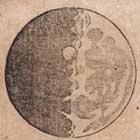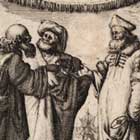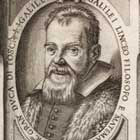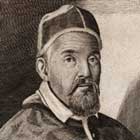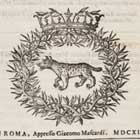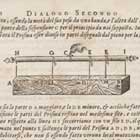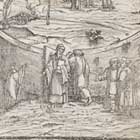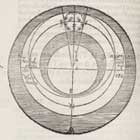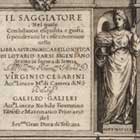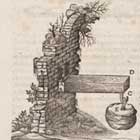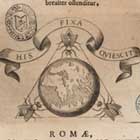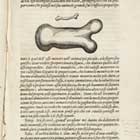This is a list of texts for the study of Galileo which are available on open access on the web. It is based on the bibliography to Galileo: Watcher of the Skies, although it includes (for example) Nelli's biography of Galileo, which is mentioned in the book but is not in the notes or bibliography, and a few other works which I used but which don't appear in the bibliography. I compiled this list in the summer of 2010, but new resources are constantly coming available, and inevitably it will not be fully up to date – the fact that a text is not on this list does not mean that it isn't now out there somewhere! This list does not include journals which are not public access – it does include some articles which, despite being in copyright, were public access when I listed them: these may cease to be public access in the future, so if the link doesn't work that's the likely explanation. University students and staff will of course be able to access many other texts through subscription services.
Anon. Naudæana et Patiniana (2nd ed., Amsterdam: François vander Plaats, 1703)
Barra, Mario. “Galileo Galilei e la probabilità ”. In LCF, 101-18.
Beretta, Francesco. “Un nuovo documento sul processo di Galileo Galilei: La lettera di Vincenzo Maculano del 22 aprile 1633”, Nuncius 16 (2001), 629-41.
Beretta, Francesco. “Urbain VIII Barberini Protagoniste de la Condemnation de Galilée”, in LCF, 549-73.
Bianchi, Luca. “Agostino Oreggi, Qualificatore del Dialogo, e i Limiti della Conoscenza Scientifica”, in LCF, 575-84.
Bredekamp, Horst. “Gazing Hands and Blind Spots: Galileo as Drafttsman”. Science in Context 13 (2000): 423-62.
Bucciantini, Massimo. “Novità Celesti e Teologia”. In LCF, 795-808.
Büttner, Jochen, Peter Damerow, and Jürgen Renn. “Traces of an Invisible Giant: Shared Knowledge in Galileo’s Unpublished Treatises”. In LCF 183-202.
Carugo, Adriano and A. C. Crombie. "The Jesuits and Galileo's Ideas of Science and Nature." Annali dell'Istituto e Museo di Storia della Scienza di Firenze 8 (1983): 3- 68.
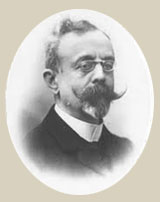
Castagnetti, Giuseppe and Michele Camerota, “Antonio Favaro and the Edizione Nazionale of Galileo's Works”, Science in Context 14S1 (2001), 357-61.
Castagnetti, Giuseppe and Michele Camerota. “Rafaello Caverni and his History of the Experimental Method in Italy”, Science in Context 14S1 (2001), 327-39.
Clavelin, Maurice. “Galilée astronome philosophe”, in LCF, 19-40
Dupré, Sven. “Ausonio's Mirrors and Galileo's Lenses: The Telescope and Sixteenth-century Practical Optical Knowledge”, Galilæana 2 (2005), 145-180
Favaro, Antonio. “La libreria di Galileo Galilei descritta ed illustrata”, Bullettino di Bibliografia e di Storia delle Scienze Matematiche e Fisiche 19 (1886), 219-93
Favino, Federica. “'Quel Petardo di mia Fortuna': Reconsiderando la 'Caduta' di Giovan Battista Ciampoli”, in LCF, 863-82.
Finocchiaro, Maurice A. “Aspects of the Controversy About Galileo's Trial”, in LCF 491-511
Fredette, Raymond. “Galileo’s De motu antiquiora: notes for a reappraisal”, in LCF, 165-82.
Galilei, Galileo. Le Opere Di Galileo Galilei. Edizione Nazionale. Ed. A. Favaro. 20 vols. in 21. (Florence: Barbera, 1890-1909)
Garcia, Stéphane. “Elie Diodati – Galilée: La Rencontre de Deux Logiques”, in LCF, 883-92.
Garcia, Stéphane. “Peiresc, Bernegger et Diodati: cinq lettres inédites en rapport avec Galilée”, Galilæana 6 (2009): 219-33.
Gingerich, Owen. “The curious case of the M-L Sidereus Nuncius.” Galilaena 6 (2009): 141-65.
Gingerich, Owen, and A. Van Helden. "From Occhiale to Printed Page: The Making of Galileo's Sidereus Nuncius." Journal for the History of Astronomy 34 (2003): 251-67.
Goldstein, Bernard R. “Galileo's Account of Astronomical Miracles in the Bible: A Confusion of Sources”. Nuncius 5 (1990): 3-16.
Hamou, Philippe. “'La Nature est Inexorable': Pour une Reconsidération de la Contribution de Galilée au Problème de la Connaissance”, Galilæana 5 (2008), 149-77.
Helbing, Mario Otto. “Galileo e le Questione meccaniche attribuite ad Aristotele”, in LCF, 217-36.
Inchofer, Melchior. La Monarchie des Solipses. Amsterdam: Herman Uytwerf, 1722.
Magalotti, Lorenzo. Delle lettere familiari. 2 vols., Firenze: SAR, 1769.
Monconys, Balthasar de. Les voyages de Balthasar de Monconys : documents pour l'histoire de la science. Paris: A. Hermann, 1887.
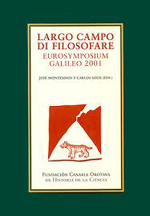
Montesinos, JosĂ©, and Carlos SolĂs eds. Largo Campo Di Filosofare. Eurosymposium Galileo 2001. La Orotava: FundaciĂłn Canaria Orotava de Historia de la Ciencia, 2001.
Mueller, Paul R. "An Unblemished Success: Galileo's Sunspot Argument in the Dialogue." Journal for the History of Astronomy 31 (2000): 279-300.
Naylor, R. H. “Galileo’s Physics for a Rotating Earth”, in LCF, 337-56.
Nelli, Giovan Battista Clemente de'. Vita e commercio litterario di Galileo (Lausanne,1793) vol. 1
Nelli, Giovan Battista Clemente de'. Vita e commercio litterario di Galileo (Lausanne,1793) vol. 2
Palisca, Claude V. “Vincenzo Galilei, Scienziato Sperimentale, Mentore del Figlio Galileo”, Nuncius 15 (2000): 497-514.
Palmieri, Paolo. "Galileo and the Discovery of the Phases of Venus." Journal for the History of Astronomy 32 (2001): 109-29.
Palmieri, Paolo. “Galileo Did Not Steal The Discovery of Venus’ Phases: A Counterargrument to Westfall”, in LCF 433-44.
Renn, JĂĽrgen and Matteo Valleriani. "Galileo and the Challenge of the Arsenal." Nuncius 16 (2001): 481-503.

Renn, Jürgen, Peter Damerow, and Simone Rieger, “Hunting the White Elephant: When and How Did Galileo Discover the Law of Fall”. Science in Context 14S1 (2001), 29-149.
Renn, JĂĽrgen, ed., Galileo in Context (Cambridge: Cambridge University Press, 2001).
Schemmel, Matthias. “England's Forgotten Galileo”. In LCF, 269-80.
Settle, Thomas B. “Experimental Sense in Galileo’s Early Works and its Likely Sources”, in LCF, 831-850.
Shea, William R. “Galileo the Copernican”, in LCF, 41-60.
Siebert, H. "The Early Search for Stellar Parallax: Galileo, Castelli, and Ramponi." Journal for the History of Astronomy 36 (2005): 251-71.
Stevens, Henry. Thomas Hariot the Mathematician, the Philosopher, and the Scholar. London: privately printed, 1900.
Torrini, Maurizio. “Galileo e la Repubblica degli Scienziati”, in LCF 783-94.
Valieriani, Matteo. “A View on Galileo’s Ricordi Autografi. Galileo Practitioner in Padua”, in LCF, 269-80.
Vickers, Brian. “Epideictic rhetoric in Galileo's Dialogo”, Annali dell'Istituto e Museo di Storia della Scienza 8 (1983): 69-102.
Vérin, Hélène. “Galilée et Antoine de Ville: Un Courier sur l'Idée de Matière”, in LCF, 307-21.
Whitaker, Ewan A. “Galileo's Lunar Observations and the Dating of the Composition of the Sidereus Nuncius”, Journal for the History of Astronomy 9 (1978): 155-69.
Wilding, Nick. “Galileo’s Idol: Gianfrancesco Sagredo Unveiled.” Galilæana 3 (2006): 229-45.
Wisan, Winifred L. “Galileo's De Systemate Mundi and the New Mechanics”, in Galuzzi ed., Novità celesti, 41-9.
Wootton, David. “New Light on the Composition and Publication of the Sidereus Nuncius.” Galilæana 6 (2009): 61-78.
Some notes:
The special issue of Science in Context on Galileo exists, confusingly, in three forms:
- as a journal issue, vol. 13 (2000), issues 3-4, pp. 271-691
- as a supplement (S1) to Science in Context 14, June 2001, pp. 1-431
- as a book (Cambridge University Press, 2001), substantially but not entirely available in preview on Google books
It is (2) which is on public access, and to which the links here lead. Confusingly the pagination of (2) and (3) is different from that of (1).
Issues of Galilaeana become public access after three years – thus recent articles listed here link only to the journal's home page: you should be able to locate them if they are more than three years old.
Issues of Journal for the History of Astronomy become public access after two years, and you should be able to locate them on adsabs.




